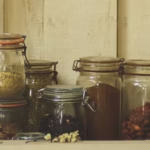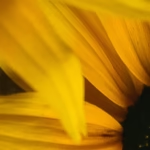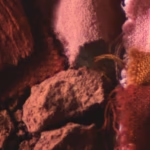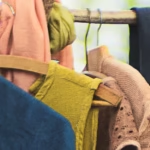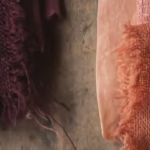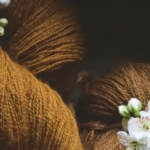3 simple recipes and 7 questions/answers
Indigo occupies an important place in plant dyeing, if only because of the numerous publications on the subject. But it also has a special place in botanical dye because its processing techniques differ from those generally used in natural dyeing.
That’s why it’s a little frightening for those who wonder how to dye with indigo. It’s true that avocado dyeing and turmeric dyeing are more immediately affordable, not least because the plant is so easy to obtain.
But dyeing with indigo is not out of reach for anyone wishing to embark on a captivating experience and understand how to make indigo dye from plants.
To help you, here are three simple indigo dyeing recipes. And I’ll try to answer a few questions I asked myself at the start of my experiments. Here are the answers I was able to give. They help us understand what happens in an indigo vat. I hope these answers will make the indigo blue natural dyeing experience easier.
1. What is indigo?
Indigo is a color steeped in history
One color, you might say: indigo blue! A color that’s instantly recognizable. A color with a long history.
Unloved in Antiquity, it was the color of barbarians and foreigners. At the time, blue eyes were considered a tare, a sign of bad living for a woman and a mark of ridicule for a man (see the chapter on color symbolism in“Le petit livre des couleurs” by Michel Pastoureau and Dominique Simmonet, in french). It was after the Middle Ages, under the influence of the Church, that blue changed its symbolism. He embodies confidence, stability and authority.
In our Western cultures, blue is now the preferred color, the one on which everyone agrees. Blue jeans, a cotton fabric dyed with indigo, made a major contribution. According to Michel Pastoureau, ” it’s the most reasonable color of all “, chosen to embody harmony and freedom. But it’s all a question of culture and history. In the Middle East and Asia, blue has a completely different meaning, symbolizing immortality or impurity…
If blue is steeped in history, it’s undoubtedly also because, from time immemorial and almost everywhere, people have made blue, thanks to indigo.
Indigo is not a plant
Indigo is not a plant, but an organic extract from plants, which, after multiple chemical reactions, directly dyes the fibers blue, a blue that is resistant to light and washing.
It was discovered “accidentally”.
A tisane of plants belonging to the Indigofera genus that makes pretty blue bubbles with a greenish juice is perhaps the beginning of the history of indigo dyeing.
2. Do indigo plants only produce blue ?
In all indigo-producing cultures, the plant was also used for purposes other than color, notably therapeutic.
Since ancient times, woad leaves have been used as a poultice to treat wounds, ulcers and snake bites, and as a decoction to treat spleen disorders.
It was also customary to wear indigo-dyed textiles for protection against insects and snakes. The smell of Indigo is said to have a repellent effect.
In traditional Chinese medicine, indigo plants are still used as medicinal plants.
Renowned for its antiviral properties, in particular against the SARS coronavirus, Chinese woad received renewed interest during the SARS epidemic in 2003.

It is also very useful as an anti-inflammatory. It is traditionally used to treat mouth and lung ailments. Also known for its depurative properties, it can also relieve the liver and purify the blood.
Since 2011, the roots of woad have been included in the European pharmacopoeia.
3. How is indigo different from other natural dyes?
In the world of natural dyes, indigo is usually distinguished from other dyes. And for at least two reasons.
3.1. Indigo is a dye that needs no mordant
In other words, there’s no need to mordant the fibers to be dyed beforehand. Indigo has a direct affinity with fiber. But that’s not its specificity, since other plants, such as turmeric or avocado, can be used to add color without the need for mordanting.
3.2. Indigo differs from other dyes in two ways
Indigo does not exist as such in indigo plants
In fact, indigo plants contain molecules called indican or isatan B and isantan B, glycosides, which, following a chemical reaction involving grinding, maceration and oxygenation, produce another chemical compound, the indigo pigment. The chemist then refers to indican or isatan B as the precursors of indigo.
The resulting indigo is a pigment, not a dye.
Last but not least, indigo, as a pigment, is insoluble. It remains suspended in a liquid, unlike a colorant, which is soluble in water. The indigo pigment needs to be “solubilized” so that it clings to the fiber to be dyed. To make it soluble, it undergoes another transformation through a chemical reaction that takes place in a tank, creating a basic, oxygen-poor environment. Indigo is a “vat” colorant. I’ll come back to this later.
To put it simply, things can be summed up as follows:
Water-soluble dyes are extracted from dye plants by decoction: quercetin for onions, luteolin for gaude and alizarin for madder… they color the water. This is the bath water in which the fibers to be dyed are immersed. This is the principle of the dye bath.
A pigment is extracted from indigo plants through a process that’s a little more complex than a simple decoction. This intensely blue indigo pigment, also known as indigotine, is made soluble in an alkaline vat and reduced in oxygen. This is the indigo vat. Simply soaking the fiber to be dyed in the vat, followed by exposure to air, is all that’s needed to dye it blue.
That’s why indigo is magic! From green leaves, a succession of chemical reactions transforms the plant material into an almost instantaneous blue indigo fabric. The most famous blue of all time.
That’s why there’s so much talk about indigo: it’s magical and mysterious. Who would have thought that a plant in the cabbage family with pretty yellow flowers, isatis tinctorial, or woad, would harbor this blue gold in its leaves?
4. What are the plant used for indigo dye? Where to find indigo in nature?
Which plants produce indigo? There are plenty of them. More than 800 plants are involved in the indigo trade secret (link in french).
Indigo trees
Thanks to their diversity and richness, Indigo trees occupy a prime position. Cultivated or wild, they can be found in Africa, Asia, India and South America. They belong to the legume family (fabaceae). These are so-called pioneer plants that fix nitrogen from the air in the soil (link in french), making it available for assimilation by other plants. These plants are not only blue, they also fertilize the soil! What more could you ask for?
Dyer’s woad
Closer to our latitudes (in France), there’s dyer’s woad, also known as “guède” (Isatis tinctoria). This is a biennial plant in the cabbage family (brassicaceae). Woad is found in the wild in southern France and Mediterranean countries, along roadsides and railroads, and in meadows. A plant that thrives in deep, well-drained clay-limestone soils. It loves warmth and sunshine. In the 15th and 16th centuries, woad cultivation was widespread in southern France, particularly in the Lauragais region. Hence the expression “pays de cocagne”: balls of crushed, dried woad leaves called cocagne, marketed for indigo dyeing.
A culture that is slowly making a comeback thanks to the hard work of enthusiasts.
Dyer’s knotweed
Dyer’s knotweed (persicaria tinctoria) is another source of indigo blue that can be grown in our climate. It belongs to the polygon family. Native to Vietnam and southern China, this herbaceous annual has acclimatized well in Europe. It likes cool, well-watered soil.
Here too, natural color enthusiasts have taken up the challenge of growing knotweed for French indigo production.
Other indigo plants are more exotic and less well-known.
All these plants contain not indigo as such, but indigo precursors, molecules which, after chemical reaction, produce the indigo pigment.
What are these chemical reactions? Or in other words…
5. How can indigo pigment be extracted from the leaves of indigo plants? How to make indigo dye from plants?
A vast literature exists on the subject, detailing ancestral know-how, the details of which vary according to the plant used. Some of these are highly sophisticated, such as “Japanese indigo”, a compost of indigo leaves skilfully dosed to obtain a concentrate of indigotine.
I’ll only cover the best-known and most accessible processes for those wishing to embark on the adventure of natural indigo blue dyeing.
5.1. Extraction of indigo by maceration
The simplest process, and certainly the first to be tried and tested, is made from fresh persicaria or woad leaves.
Anne Varichon (link in french) explains the steps involved in maceration extraction.
“To dye 500gr of wool, silk, linen or cotton: Scald 500 grams of fresh leaves with 4 liters of water and let the temperature drop to (122°F or 50°C). Keep it stable for one day. Enzymes present in the leaves and secreted by bacteria also present on the leaves cause hydrolysis of the precursors. When bubbles appear on the surface of the bath (a sign of fermentation), add 6 grams of slaked lime and stir, maintaining the temperature at 122°F (or 50°C) for a further three hours. Finally, insert the wet cloth, keep it submerged for a few minutes, then remove and air-dry. Repeat the operation until the desired shade is achieved.“.
Anne Varichon, Couleurs, pigments et teintures dans les mains des peuples, Seuil, 2005, p.149 (link in french).
Although simple, the process was soon abandoned because of its disadvantages: very pale bruises and long, repeated soaking times.
Si vous avez un peu de pastel qui pousse autour de chez vous, il peut être amusant de tenter l’expérience, très accessible pour avoir du bleu à portée de main.
Other, slightly more sophisticated extraction processes were soon implemented, enabling higher indigo concentrations to be obtained.
5.2. Extracting indigo by composting
This process has existed since antiquity. It continues to this day. The leaves are crushed, dried and composted. They are then shaped into shells or cocagnes, then into agranat, or “pastel agranat”, to facilitate marketing. In Japan, the same know-how exists with parsley leaves, known as “Sukumo aï”.
The composting process concentrates the organic matter and extracts the indigo thanks to the work of micro-organisms that form a veritable indigo leaven.
Today, this way of working is practiced by master indigo dyers, who perpetuate an ancestral know-how.
There’s one final pigment extraction process, discovered in the 18th century and used today by most indigo producers: a process using fresh leaves, which is simpler and quicker than composting and yields equally concentrated indigo.
5.3. Extraction of indigo by precipitation
Freshly harvested leaves are macerated in large vats of hot water. The infusion is collected and filtered. It is then beaten to oxygenate it, with the addition of a little lime.
This oxygenation precipitates indoxyl, the precursor found in the plant’s juice, into indigo flakes. The indigo pigment settles to the bottom of the vat, as it is insoluble. It is filtered and dried.
The blue powdered indigo pigment you find in shops has been extracted in this way. You can find it in stores or in the kits I suggest (link in french).
For the curious and adventurous, the recipe booklet contains instructions for making this type of indigo from indigofera tinctoria leaf powder. A process I had experimented with during a workshop with Michel Garcia (link in french).
It can be easily implemented at home.
All that remains is to make this indigo soluble so that it can be dyed. This is the indigo vat stage.
6. How to make indigo soluble?
A quick summary of the previous steps to make sure I haven’t lost you along the way. The leaves of indigo plants contain chemical compounds known as indigo precursors, which undergo a chemical reaction (grinding, composting, maceration or oxygenation) to transform into indigo pigment (in the form of shells, powder or paste).
6.1. The indigo vat, a necessary and indispensable condition for making the pigment soluble
There are a multitude of indigo vat recipes. Each master dyer specializing in indigo has his own secrets, his own know-how, which he has learned through experience.
Because when it comes to indigo, recipes aren’t everything.
It guides us in our first steps, and then experience and observation allow us to move forward, sometimes groping, but always progressing.
A vat of indigo is a bit like leaven for bread-makers, or a brewery for beer-makers. It’s alive.
You get to know it by sight, smell and, for some, even taste.
Despite their diversity, all these tank recipes have two things in common:
- an alkaline environment. Soda ash, potash, lime and even urine are used…
- an oxygen-reduced environment with metal salts, synthetic products such as sodium hydrosulfite, or organic matter.
These two conditions are essential to transform indigo pigment into indigo dye.
6.2. Three simple indigo vat recipes to discover how to make indigo dye
I’m not a master dyer specializing in indigo. But through training, notably with Michel Garcia, and practice, I came to understand how an indigo vat works.
This is what I present in a recipe booklet (link in french) and an indigo dyeing kit (link in french). I suggest three ways of making an indigo vat. These are the ones I use, natural and ecological tanks. They are relatively simple and effective. I’ll also give you a few tips on maintaining your tank and understanding how it works. So you’re ready to dye with indigo
This notebook is the fruit of a long process of drafting and design, and above all, of experimentation, practice and successful and unsuccessful trials…
Here are some examples of the colors obtained on embroidery threads (link in french).
7. One last question : Are there any other plants that make blue ?
As far as I know, there are two other plant sources of blue.
I get a sort of navy blue with campeche wood after a symplocos mordanting. It’s campeche blue. Indigo can be combined with campeche to obtain dark blues or purples.
And another source, more mysterious to me. In my garden, a young tree, a clerodendrum trichotomum, is growing, very pretty, with delicately scented flowers. In autumn, blue berries appear. Birds love them. These berries could be used to dye blue. For the time being, the tree is too young and has yet to bear fruit. I look forward to it. And I’ll tell you more about it as soon as I’ve been able to harvest the first fruits.
Indigo dyeing remains the most widespread technique for obtaining blue. I hope you’ll be able to experiment with these three simple recipes and learn how to make indigo dye.
You can watch a short video presentation of indigo dyeing (in french).
